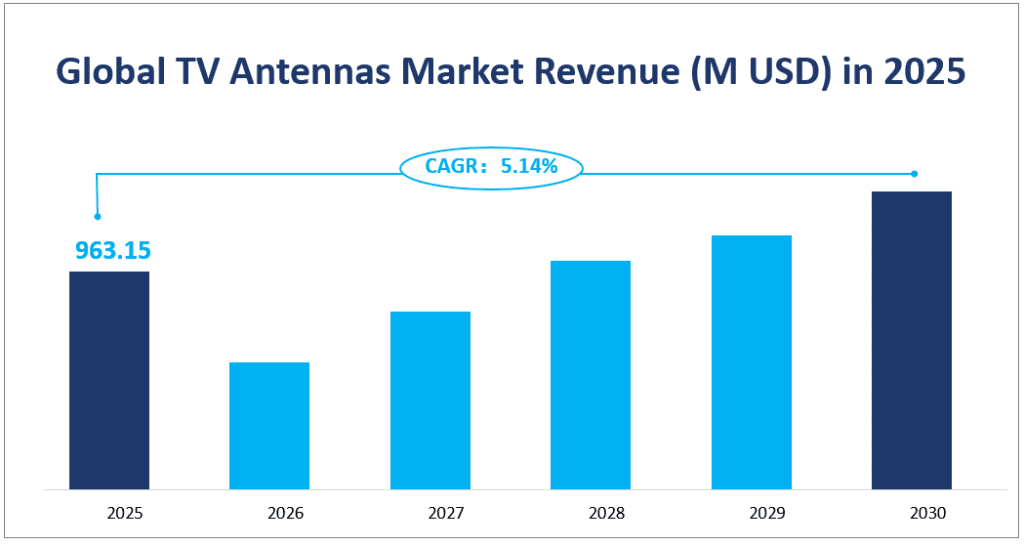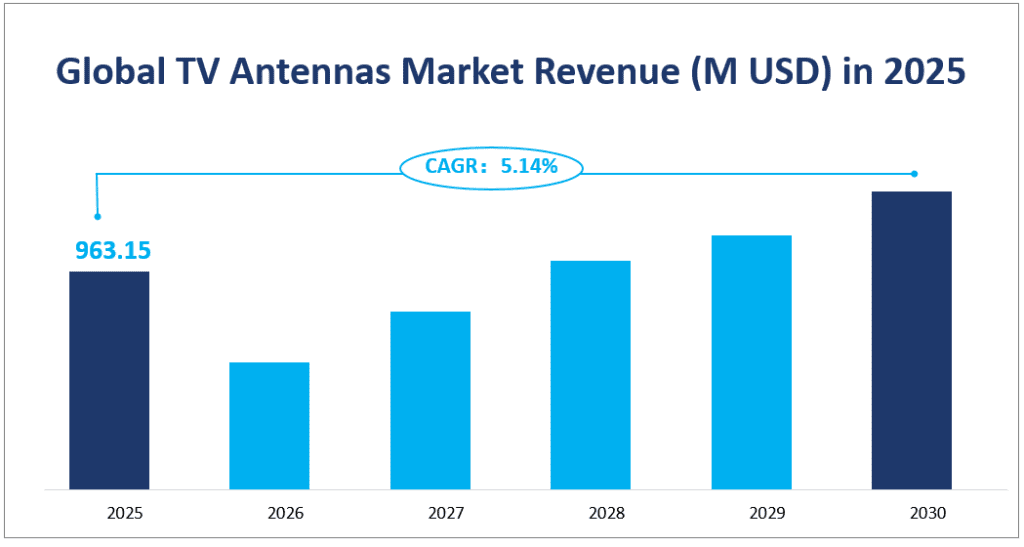1. Global TV Antennas Market Overview
The global TV antennas market is projected to reach a value of approximately $963.15 million by 2025 with a CAGR of 5.14% from 2025 to 2030. This growth can be attributed to the increasing demand for cost-effective entertainment solutions, particularly in the wake of the COVID-19 pandemic, which has shifted consumer behavior towards home-based entertainment.
TV antennas are devices designed to receive over-the-air broadcast signals from television stations. They convert electromagnetic waves into electrical signals, allowing viewers to access free television programming without the need for cable or satellite subscriptions. There are two primary types of TV antennas: indoor antennas and outdoor antennas. Indoor antennas are typically smaller and designed for use within homes, while outdoor antennas are larger and installed on rooftops or masts to capture signals from a greater distance.
The functionality of TV antennas is determined by several factors, including their design, frequency range, and gain. The frequency range for TV antennas typically spans from VHF (Very High Frequency) to UHF (Ultra High Frequency) bands, allowing them to receive a wide array of channels. The gain of an antenna, measured in decibels (dB), indicates its ability to amplify signals. A higher gain means better reception, especially in areas with weak signals.
Global TV Antennas Market Revenue (M USD) in 2025


2. Driving Factors of the TV Antennas Market
Cost-Effectiveness: One of the primary drivers of TV antennas market growth is the increasing demand for cost-effective entertainment solutions. As consumers seek to reduce their monthly expenses, many are turning to TV antennas as a viable alternative to expensive cable and satellite subscriptions. TV antennas provide access to a wide range of channels without the recurring costs associated with pay-TV services.
Technological Advancements: Innovations in antenna technology have also contributed to market growth. Modern TV antennas are designed to be more efficient and user-friendly, with features such as multi-directional reception and built-in amplifiers that enhance signal strength. These advancements have made it easier for consumers to install and use antennas, further boosting their popularity.
High-Definition Broadcasting: The transition to high-definition (HD) broadcasting has made TV antennas more appealing to consumers. Antennas can receive uncompressed HD signals, providing superior picture quality compared to standard-definition cable services. As more broadcasters offer HD content, the demand for antennas that can capture these signals is expected to rise.
3. Limiting Factors of TV Antennas Market
Competition from Streaming Services: One of the significant limiting factors for the TV antenna market is the growing popularity of streaming services such as Netflix, Hulu, and Amazon Prime Video. These platforms offer a vast library of content that can be accessed on-demand, making them an attractive alternative to traditional broadcast television. As consumers increasingly embrace streaming, the demand for TV antennas may face competition.
Limited Channel Availability: In some regions, the availability of channels through TV antennas may be limited compared to cable or satellite options. This can deter potential users who are looking for a comprehensive viewing experience. Consumers may be hesitant to invest in antennas if they believe they will miss out on popular channels or programming.
Geographic Limitations: The effectiveness of TV antennas can vary significantly based on geographic location. Areas with weak broadcast signals may struggle to receive reliable reception, limiting the appeal of antennas in those regions. Consumers in rural or remote areas may find it challenging to access the channels they desire, which could hinder market growth.
Regulatory Challenges: Regulatory issues related to broadcasting rights and spectrum allocation can also impact the TV antenna market. Changes in regulations may affect the availability of certain channels or the ability of antennas to receive signals, creating uncertainty for consumers and manufacturers alike.
4. TV Antenna Market Segment
Product Types
The global TV antenna market is segmented into two primary product types: Indoor TV Antennas and Outdoor TV Antennas. Each type has its unique characteristics and market dynamics, which influence their respective market values and growth rates.
Outdoor TV antennas hold the largest market share, accounting for approximately 67.6% of with a market value of $650.90 million in 2025. This dominance is attributed to their ability to capture stronger signals over longer distances, making them suitable for a broader range of applications, including both residential and commercial use.
The fastest-growing product type is the Outdoor TV Antenna, with a projected size of $312.25 million in 2025. This growth rate is significantly higher than that of indoor antennas, primarily due to the increasing demand for high-quality signal reception in both urban and rural areas. Outdoor antennas are often preferred for their superior performance, especially in regions with weak broadcast signals.
Market by Applications
The residential application segment holds the largest market share, accounting for approximately 74.6% with a market value of $718.15 million in 2025. This dominance is due to the widespread use of TV antennas in homes, driven by the increasing trend of cord-cutting and the desire for cost-effective entertainment solutions.
The residential application segment also has the fastest-growing rate, with a projected value of $245.00 million in 2025. This growth is primarily driven by the increasing number of households seeking to reduce their reliance on cable and satellite services.
The residential application segment is the largest and fastest-growing segment in the TV antennas market. The increasing trend of cord-cutting, where consumers opt for free broadcast television over cable or satellite services, has significantly driven the demand for TV antennas in homes.
The commercial application segment includes the use of TV antennas in hotels, restaurants, offices, and other commercial spaces. While this segment is smaller than the residential market, it is still a significant contributor to the overall market value. The demand for commercial antennas is driven by the need for reliable and cost-effective broadcasting solutions in these settings.
Market Value by Segment
| Market Value (M USD) in 2025 | ||
| By Type | Indoor TV Antenna | 312.25 |
| Outdoor TV Antenna | 650.90 | |
| By Application | Residential | 718.15 |
| Commercial | 245.00 |
5. Regional TV Antenna Market
The global TV antenna market is segmented into several major regions, each with its unique market dynamics and growth trajectories. By 2025, the market value in each region is projected to vary significantly, influenced by factors such as economic conditions, consumer preferences, and technological advancements.
The market in North America is expected to grow at a CAGR of approximately 4.58% from 2020 to 2025 with a market value of $284.76 million in 2025. This region has historically been a significant market for TV antennas, driven by the high adoption of advanced technologies and the presence of major manufacturers.
Europe is projected to grow at a CAGR of 4.92% over the same period with a market value of $270.78 million in 2025. The region’s market is influenced by regulatory policies and the increasing demand for high-definition broadcasts, which drive the need for advanced TV antennas.
The Asia Pacific region is expected to grow at a CAGR of 2.76% from 2020 to 2025 with a market size of $308.96 million in 2025. This region’s market is driven by rapid economic growth and increasing urbanization, which boost the demand for TV antennas.
The market in the Middle East and Africa is projected to grow at a CAGR of 4.41% over the same period with a market value of $57.59 million in 2025. This region’s market is influenced by the increasing adoption of digital broadcasting and the need for reliable signal reception in both urban and rural areas.
South America is expected to grow at a CAGR of 4.65% from 2020 to 2025 with a market revenue of $41.06 million in 2025. The region’s market is driven by the increasing demand for cost-effective entertainment solutions and the growing popularity of digital broadcasting.
The Asia Pacific region is projected to have the largest market value by 2025. This dominance is attributed to the region’s rapid economic growth, increasing urbanization, and the rising demand for advanced TV antennas to support high-definition broadcasts.
The South American region is expected to be the fastest-growing market. This growth is driven by the increasing demand for cost-effective entertainment solutions and the growing popularity of digital broadcasting in the region.
Global TV Antennas Revenue (M USD) by Regions in 2025


6. Top 3 Companies in the TV Antenna Market
Company Introduction and Business Overview:
Antop is a leading global manufacturer of TV antennas, founded in 1980. The company is headquartered in China and primarily serves markets in America and Europe. Antop is renowned for its innovative and high-quality antenna solutions, focusing on delivering the best free 4K and 8K HDTV experiences.
Products Offered:
Antop offers a wide range of TV antennas, including indoor and outdoor models. Their flagship product, the “Big Boy” AT-400BV, is an outdoor/indoor HDTV antenna designed with advanced digital technology to enhance VHF reception. It features UV coating for weather resistance and can feed multiple TVs with a range of up to 85 miles.
Company Introduction and Business Overview:
Antennas Direct, founded in 2003, is a pioneer in the digital TV antenna industry. Headquartered in the USA, the company focuses on delivering high-quality TV antennas that provide reliable reception of free broadcast TV signals at affordable prices. Antennas Direct is committed to helping consumers cut the cord and enjoy free TV programming.
Products Offered:
Antennas Direct offers a variety of indoor and outdoor antennas, including the ClearStream ECLIPSE™ 2 Indoor Antenna. This antenna is designed for cord-cutters, offering a true 60-mile range with a multi-directional reception capability. It features a reversible design that can be painted to match any décor and includes peel & stick strips for easy installation.
Company Introduction and Business Overview:
Winegard, founded in 1953, is a trusted connectivity partner specializing in the design and manufacture of a wide range of world-class connectivity products and services. Headquartered in the USA, Winegard offers solutions for residential, commercial, and mobile applications, including WiFi, 4G LTE, satellite, broadband, video, and over-the-air technology.
Products Offered:
Winegard’s product portfolio includes the Classic Series Yagi YA7000C, a compact Yagi antenna designed for uniform gain across low-band VHF, high-band VHF, and UHF channels. This antenna offers a range of up to 70 miles, making it suitable for both residential and commercial use.
In 2020, Winegard’s sales revenue was approximately USD 17.63 million.
Major Players
| Company Name | Plants Distribution | Sales Region |
| Antop | China | Mainly in America and Europe |
| Antennas Direct | USA | Mainly in America and Europe |
| Winegard | USA | Mainly in America |
| Xujun Electronics Co., Ltd | China | Mainly in Asia and Europe |
| Channel Master | USA | Mainly in America and Europe |
| LAVA Electronics | USA | Mainly in America |
| Tuko | China | Mainly in Asia and Europe |
| VOXX Accessories Corporation (VAC) | USA | Mainly in America |
| 1byone | USA | Mainly in America |
| Gisantone | China | Mainly in Asia and Europe |
1 TV Antennas Introduction and Market Overview
1.1 Objectives of the Study
1.2 Overview of TV Antennas
1.3 Scope of The Study
1.3.1 Key Market Segments
1.3.2 Players Covered
1.3.3 COVID-19’s impact on the TV Antennas industry
1.4 Methodology of The Study
1.5 Research Data Source
2 Executive Summary
2.1 Market Overview
2.1.1 Global TV Antennas Market Size, 2015 – 2020
2.1.2 Global TV Antennas Market Size by Type, 2015 – 2020
2.1.3 Global TV Antennas Market Size by Application, 2015 – 2020
2.1.4 Global TV Antennas Market Size by Region, 2015 – 2025
2.2 Business Environment Analysis
2.2.1 Global COVID-19 Status and Economic Overview
2.2.2 Influence of COVID-19 Outbreak on TV Antennas Industry Development
3 Industry Chain Analysis
3.1 Upstream Raw Material Suppliers of TV Antennas Analysis
3.2 Major Players of TV Antennas
3.3 TV Antennas Manufacturing Cost Structure Analysis
3.3.1 Production Process Analysis
3.3.2 Manufacturing Cost Structure of TV Antennas
3.3.3 Labor Cost of TV Antennas
3.4 Market Distributors of TV Antennas
3.5 Major Downstream Buyers of TV Antennas Analysis
3.6 The Impact of Covid-19 From the Perspective of Industry Chain
3.7 Regional Import and Export Controls Will Exist for a Long Time
3.8 Continued downward PMI Spreads Globally
4 Global TV Antennas Market, by Type
4.1 Global TV Antennas Value and Market Share by Type (2015-2020)
4.2 Global TV Antennas Production and Market Share by Type (2015-2020)
4.3 Global TV Antennas Value and Growth Rate by Type (2015-2020)
4.3.1 Global TV Antennas Value and Growth Rate of Indoor TV Antenna (2015-2020)
4.3.2 Global TV Antennas Value and Growth Rate of Outdoor TV Antenna (2015-2020)
4.4 Global TV Antennas Price Analysis by Type (2015-2020)
5 TV Antennas Market, by Application
5.1 Downstream Market Overview
5.2 Global TV Antennas Consumption and Market Share by Application (2015-2020)
5.3 Global TV Antennas Consumption and Growth Rate by Application (2015-2020)
5.3.1 Global TV Antennas Consumption and Growth Rate of Residential (2015-2020)
5.3.2 Global TV Antennas Consumption and Growth Rate of Commercial (2015-2020)
6 Global TV Antennas Market Analysis by Regions
6.1 Global TV Antennas Sales, Revenue and Market Share by Regions
6.1.1 Global TV Antennas Sales by Regions (2015-2020)
6.1.2 Global TV Antennas Revenue by Regions (2015-2020)
6.2 North America TV Antennas Sales and Growth Rate (2015-2020)
6.3 Europe TV Antennas Sales and Growth Rate (2015-2020)
6.4 Asia-Pacific TV Antennas Sales and Growth Rate (2015-2020)
6.5 Middle East and Africa TV Antennas Sales and Growth Rate (2015-2020)
6.6 South America TV Antennas Sales and Growth Rate (2015-2020)
7 North America TV Antennas Market Analysis by Countries
7.1 The Influence of COVID-19 on North America Market
7.2 North America TV Antennas Sales, Revenue and Market Share by Countries
7.2.1 North America TV Antennas Sales by Countries (2015-2020)
7.2.2 North America TV Antennas Revenue by Countries (2015-2020)
7.3 United States TV Antennas Sales and Growth Rate (2015-2020)
7.4 Canada TV Antennas Sales and Growth Rate (2015-2020)
7.5 Mexico TV Antennas Sales and Growth Rate (2015-2020)
8 Europe TV Antennas Market Analysis by Countries
8.1 The Influence of COVID-19 on Europe Market
8.2 Europe TV Antennas Sales, Revenue and Market Share by Countries
8.2.1 Europe TV Antennas Sales by Countries (2015-2020)
8.2.2 Europe TV Antennas Revenue by Countries (2015-2020)
8.3 Germany TV Antennas Sales and Growth Rate (2015-2020)
8.4 UK TV Antennas Sales and Growth Rate (2015-2020)
8.5 France TV Antennas Sales and Growth Rate (2015-2020)
8.6 Italy TV Antennas Sales and Growth Rate (2015-2020)
8.7 Spain TV Antennas Sales and Growth Rate (2015-2020)
8.8 Russia TV Antennas Sales and Growth Rate (2015-2020)
9 Asia Pacific TV Antennas Market Analysis by Countries
9.1 The Influence of COVID-19 on Asia Pacific Market
9.2 Asia Pacific TV Antennas Sales, Revenue and Market Share by Countries
9.2.1 Asia Pacific TV Antennas Sales by Countries (2015-2020)
9.2.2 Asia Pacific TV Antennas Revenue by Countries (2015-2020)
9.3 China TV Antennas Sales and Growth Rate (2015-2020)
9.4 Japan TV Antennas Sales and Growth Rate (2015-2020)
9.5 South Korea TV Antennas Sales and Growth Rate (2015-2020)
9.6 India TV Antennas Sales and Growth Rate (2015-2020)
9.7 Southeast Asia TV Antennas Sales and Growth Rate (2015-2020)
9.8 Australia TV Antennas Sales and Growth Rate (2015-2020)
10 Middle East and Africa TV Antennas Market Analysis by Countries
10.1 The Influence of COVID-19 on Middle East and Africa Market
10.2 Middle East and Africa TV Antennas Sales, Revenue and Market Share by Countries
10.2.1 Middle East and Africa TV Antennas Sales by Countries (2015-2020)
10.2.2 Middle East and Africa TV Antennas Revenue by Countries (2015-2020)
10.3 Saudi Arabia TV Antennas Sales and Growth Rate (2015-2020)
10.4 UAE TV Antennas Sales and Growth Rate (2015-2020)
10.5 Egypt TV Antennas Sales and Growth Rate (2015-2020)
10.6 Nigeria TV Antennas Sales and Growth Rate (2015-2020)
10.7 South Africa TV Antennas Sales and Growth Rate (2015-2020)
11 South America TV Antennas Market Analysis by Countries
11.1 The Influence of COVID-19 on Middle East and Africa Market
11.2 South America TV Antennas Sales, Revenue and Market Share by Countries
11.2.1 South America TV Antennas Sales by Countries (2015-2020)
11.2.2 South America TV Antennas Revenue by Countries (2015-2020)
11.3 Brazil TV Antennas Sales and Growth Rate (2015-2020)
11.4 Argentina TV Antennas Sales and Growth Rate (2015-2020)
11.5 Columbia TV Antennas Sales and Growth Rate (2015-2020)
11.6 Chile TV Antennas Sales and Growth Rate (2015-2020)
12 Competitive Landscape
12.1 Competitive Landscape Changes Caused by COVID-19 Outbreak
12.2 Antop
12.2.1 Company Profiles
12.2.2 TV Antennas Product Introduction
12.2.3 Antop Sales, Value, Price, Gross Margin 2015-2020
12.3 Antennas Direct
12.3.1 Company Profiles
12.3.2 TV Antennas Product Introduction
12.3.3 Antennas Direct Sales, Value, Price, Gross Margin 2015-2020
12.4 Winegard
12.4.1 Company Profiles
12.4.2 TV Antennas Product Introduction
12.4.3 Winegard Sales, Value, Price, Gross Margin 2015-2020
12.5 Xujun Electronics Co., Ltd
12.5.1 Company Profiles
12.5.2 TV Antennas Product Introduction
12.5.3 Xujun Electronics Co., Ltd Sales, Value, Price, Gross Margin 2015-2020
12.6 Channel Master
12.6.1 Company Profiles
12.6.2 TV Antennas Product Introduction
12.6.3 Channel Master Sales, Value, Price, Gross Margin 2015-2020
12.7 LAVA Electronics
12.7.1 Company Profiles
12.7.2 TV Antennas Product Introduction
12.7.3 LAVA Electronics Sales, Value, Price, Gross Margin 2015-2020
12.8 Tuko
12.8.1 Company Profiles
12.8.2 TV Antennas Product Introduction
12.8.3 Tuko Sales, Value, Price, Gross Margin 2015-2020
12.9 VOXX Accessories Corporation (VAC)
12.9.1 Company Profiles
12.9.2 TV Antennas Product Introduction
12.9.3 VOXX Accessories Corporation (VAC) Sales, Value, Price, Gross Margin 2015-2020
12.10 1byone
12.10.1 Company Profiles
12.10.2 TV Antennas Product Introduction
12.10.3 1byone Sales, Value, Price, Gross Margin 2015-2020
12.11 Gisantone
12.11.1 Company Profiles
12.11.2 TV Antennas Product Introduction
12.11.3 Gisantone Sales, Value, Price, Gross Margin 2015-2020
13 Industry Outlook
13.1 Market Driver Analysis
13.1.1 Market Restraints Analysis
13.1.2 Market Trends Analysis
13.2 Merger, Acquisition and New Investment
13.3 News of Product Release
14 Global TV Antennas Market Forecast
14.1 Global TV Antennas Market Value & Volume Forecast, by Type (2020-2025)
14.1.1 Indoor TV Antenna Market Value and Volume Forecast (2020-2025)
14.1.2 Outdoor TV Antenna Market Value and Volume Forecast (2020-2025)
14.2 Global TV Antennas Market Value & Volume Forecast, by Application (2020-2025)
14.2.1 Residential Market Value and Volume Forecast (2020-2025)
14.2.2 Commercial Market Value and Volume Forecast (2020-2025)
14.3 TV Antennas Market Analysis and Forecast by Region
14.3.1 North America Market Value and Consumption Forecast (2020-2025)
14.3.2 Europe Market Value and Consumption Forecast (2020-2025)
14.3.3 Asia Pacific Market Value and Consumption Forecast (2020-2025)
14.3.4 Middle East and Africa Market Value and Consumption Forecast (2020-2025)
14.3.5 South America Market Value and Consumption Forecast (2020-2025)
15 New Project Feasibility Analysis
15.1 Industry Barriers and New Entrants SWOT Analysis
15.1.1 Porter’s Five Forces Analysis
15.1.2 New Entrants SWOT Analysis
15.2 Analysis and Suggestions on New Project Investment
